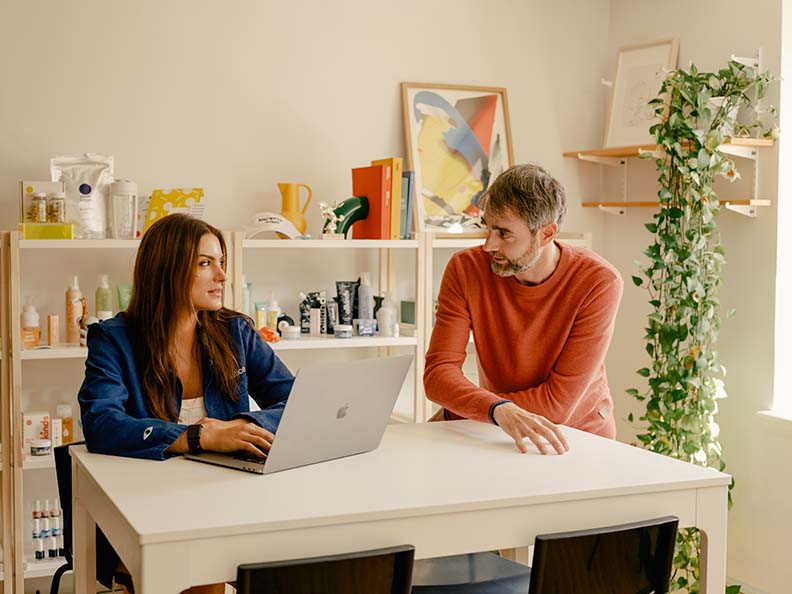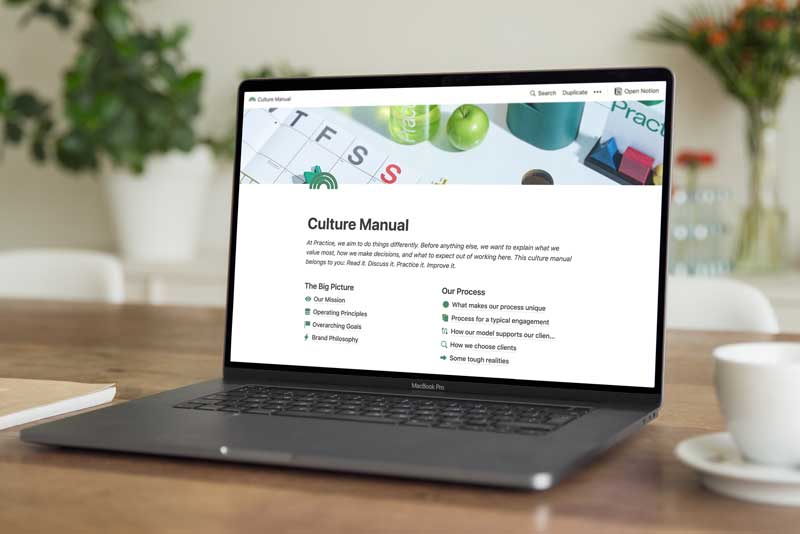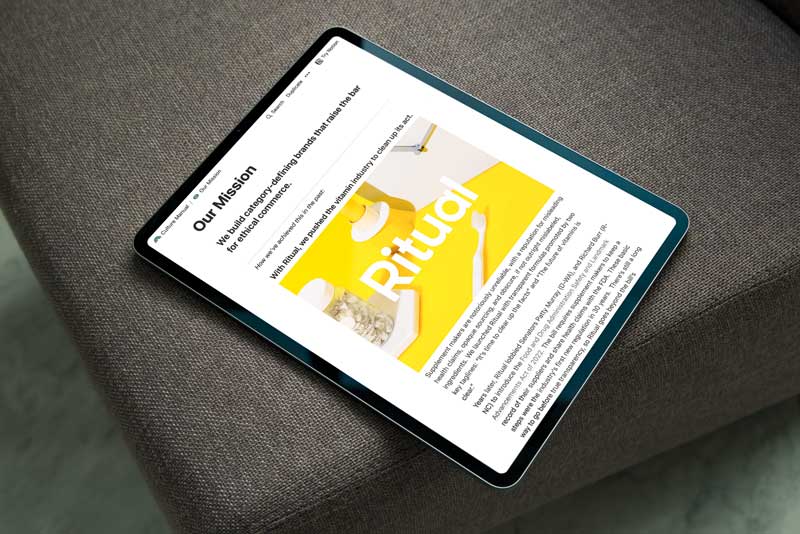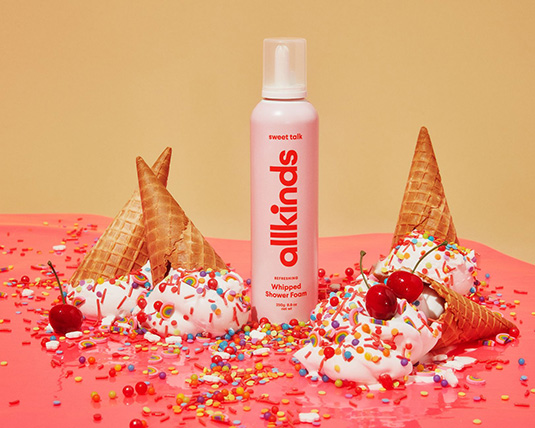
Michelle Mattar, founder of Practice.
Case Studies → Practice
Practice helps employees speak up and grow professionally
Practice is a creative brand building house led by Michelle Mattar. With clients like Ritual, Glowbar, and AllKinds, her team works with a select few on projects of 1-2 years.

Our Role
360º Assessment
Content Design
Industry
Design
Headquarters
Brooklyn, NY
I didn’t understand that a good culture manual was more like insurance against accidents than an inspirational essay about the company. As a founder, I’m comfortable with ambiguity, but this really helps us support a range of personalities and learning styles.
Challenge
Create “a safe, positive environment” for sensitive feedback
Michelle: Practice was still in its early days, I wanted to encourage employees to speak up in a way that would help improve our culture—especially the ones just starting to enter the workforce, who may not have as much confidence to do so. I needed to make Practice a safe and positive environment to speak up, and I wanted to understand what we needed to have a more open culture. More than anything, I want our culture to be a safe and productive space, with the tools to make it better.

Practice’s studio in Brooklyn, NY.
Solution
Getting “a little uncomfortable, in a good way”
Michelle: Hear Me Out forced me to get a little uncomfortable, in a good way. Some of the things we heard, I knew, but it was nice to see them written out. And others showed that Hear Me Out got people to open up in a way I wasn’t able to in a small business, where it can be extra-intimidating to talk to your boss. I really enjoyed how the report was laid out, with links to tools, reading, and homework. It felt like more than just, “here’s the information,” but also “here’s how you can learn from this.”

Michelle and Ben at Practice’s studio in Brooklyn, New York.
A handbook that’s “more insurance than inspirational essay”
Michelle: It was tricky to wrap my head around what the handbook would look like. I didn’t realize how bespoke it would be to the feedback. I imagined we’d fit into some kind of framework Hear Me Out uses. But instead, we workshopped all the things that could go wrong, and designed the manual to include what we need in place to prevent them.
I already had an employee handbook, so I wasn’t sure how a culture manual would be different. The ones I’ve seen are all about the company. But they don’t explain what to do if you’re uncomfortable or something goes wrong. For example, we have a page called “some tough realities.”
I’ve never seen any document in this style. I’ve only ever seen the “everything’s perfect, look how amazing we are,” versions. So I didn’t understand that a good culture manual was more like insurance against accidents than an inspirational essay about the company.

Homepage of Practice’s new culture manual.
Results
Supporting “a range of personalities and working styles”
Michelle: One of the big things we got from this process was clarity. That was a big theme from the feedback: some things still felt unclear. Details like how leadership works, how to escalate an issue, or how to grow in a small company.
Now, the expectations are all laid out, I can direct people where to go if they have questions, and they know what’s okay and what’s not okay. We had also seen some examples of employee misconduct in the past, and now, the sign is on the door. As a founder, I’m comfortable with ambiguity, but this really helps us support a range of personalities and learning styles.
Helping new hires quickly resolve issues on their own
Michelle: I have a new hire who started four weeks ago. Within the first week or two, I noticed them leveraging some of the things in the culture manual. And what could have been moments where things could have easily gone wrong, or led to a bad experience, actually ended up being really good experiences. They knew exactly what to do, and things were resolved immediately. And I felt really confident that there was no gray area, which feels like a huge accomplishment for any team.

”Our Mission“ page on Practice’s new culture manual.
A more transparent culture with “super-direct” honesty
Michelle: In one-on-ones, there’s a lot more transparency, and people come with super-direct, awesome honesty. But we’ve done our anonymous feedback loop, and I’m not seeing any negative feedback—people feel safe, comfortable, and excited.
It’s hard to measure, but very rewarding. For example, we added a new section on standards and procedures to the manual today, which came from that direct and honest employee feedback. We all built the brief together, and workshopped our processes to make them even better. It’s a very democratic, open, inclusive document.
Giving early-career employees the tools to grow professionally
Michelle: It’s hard to give people the guardrails to communicate effectively, especially early in their careers. I saw we needed to outline some things I thought were common professional norms. I didn’t know this process could do that—I thought it would be mostly things I could absorb. I thought I’d learn from what happened in the past, but not that I’d have the tools to prevent it in the future.
Eliminating the “square peg, round hole” dilemma
Michelle: Practice is a small business, and we intend to stay that way. And some people automatically think, “I can’t grow at a small company,” when we’ve got so much opportunity. The culture manual helps people see more clearly what we can offer that others can’t. Our projects take a year to two years, and this puts out what you’re signing up for in a way that makes us more of a team.
Our work even added clarity to hiring, by forcing us to think about who might be most suited for what we can offer. Otherwise, it’s a square peg, round hole situation—and I’ve been there, and not realized. I want candidates to read this, to make sure we’re as much of a good fit for them as they are for us.

Brands like AllKinds, a self-care brand for kids, take 1-2 years to develop. The culture manual “puts out what you’re signing up for in a way that makes us more of a team.“



